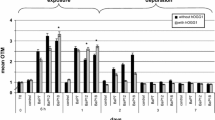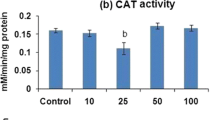Abstract
There is little information on exposure of marine mammals to genotoxic environmental contaminants. The 32P-postlabeling assay has been successfully used to assess exposure to genotoxic polycyclic aromatic compounds in fish and humans. In the present study, a preliminary investigation showed that polycyclic aromatic compound-like DNA adducts were present in hepatic tissues of harbor seals (Phoca vitulina richardsi) exposed to petroleum following the Exxon Valdez oil spill. However, for marine mammals, effects from changes in tissue condition on DNA recovery and quality is of concern, because tissue samples are often collected from animals that have been dead for unknown periods of time. To assess the effects of postmortem thermal history on DNA recovery from tissue and on DNA adduct quantitation, samples of harbor porpoise (Phocoena phocoena) hepatic tissue were incubated for up to 10 d at 4 and 30 °C. Only traces (<4 μg) of hepatic DNA were recovered from 200 mg of tissue after incubation at 30 °C for 36 h. At 4 °C, DNA (50–130 μg) was recovered from tissue incubated for up to 6 d; whereas DNA recovery at 10 d was minimal. Chromatograms of 32P-labeled DNA digests of liver tissue held at 4 and 30 °C and salmon sperm DNA held at 30 °C for 2 d had comparable profiles, suggesting that alteration of DNA bases had occurred during incubation of porpoise liver tissue. Moreover, the chromatograms of DNA extracted from liver tissues of harbor porpoises caught incidentally in a northwest Atlantic fishery, packed in ice and sampled several days later also exhibited similar altered DNA structures. Although, altered DNA structures that can interfere with the DNA adduct quantitation were present in autolyzed tissue, changes in the 32P-postlabeling chromatography conditions can decrease the interference. Moreover, in a study with tissues taken from California sea lions (Zalophus californianus) immediately postmortem and stored at –80 °C until processing, DNA structures associated with tissue breakdown were not observed. The DNA from sea lions, however, had putative age-dependent hepatic DNA modifications, which have a distinctive profile, and must be considered when evaluating exposure of marine mammals to polycyclic aromatic compounds. Overall, the findings showed that with attention to the postmortem thermal history of the tissue samples hepatic DNA adducts, as measured by 32P-postlabeling, have the potential to serve as a biological indicator of exposure of marine mammals to environmental genotoxic compounds.
Similar content being viewed by others
References
Bar, W., Kratzer, A., Machler, M. and Schmid, W.: 1988, ‘Postmortem stability of DNA', Forensic Sci. Internat. 39, 59–70.
Beland, P., De Guise, S. and Plante, R.: 1992, ‘Toxicology and pathology of St. Lawrence marine mammals', Final Report, Wildlife Toxicology Fund, WWF, Research Grant 1988–91, St. Lawrence National Institute of Ecotoxicology, Quebec, Canada.
Carvan III, M. J., Flood, L. P., Campbell, B. D. and Busbee, D. L.: 1995, ‘Effects of benzo[a]pyrene and tetrachlorodibenzo[p]dioxin in fetal dolphin kidney cells: Inhibition of proliferation and initiation of DNA damage', Chemosphere 30, 187–198.
Dunn, B. P., Black, J. J. and Maccubbin, A.: 1987, ‘32P-postlabeling analysis of aromatic DNA adducts in fish from polluted areas', Cancer Res. 47, 6543–6548.
Frost, K. J., Manen, C.-A. and Wade, T. L.: 1994, ‘Petroleum hydrocarbons in tissues of harbor seals from Prince William Sound and the Gulf of Alaska', in Loughlin, T. R. (ed.), Marine Mammals and the Exxon Valdez, Academic Press, San Diego, U.S.A., pp. 331–358.
Goksoyr, A., Solbakken, J. E., Tarlebo, J. and Klungsoyr, J.: 1986, ‘Initial characterization of the hepatic microsomal cytochrome P-450 system of the Piked Whale (Minke)’ Balaenoptera acutorostrata, Mar. Environ. Res. 19, 185–203.
Gupta, R. C.: 1985, ‘Enhanced sensitivity of 32P-postlabeling analysis of aromatic carcinogen DNA adducts', Cancer Res. 45, 5656–5662.
Gupta, R. C.: 1989, ‘Newly detected DNA damage at physiological temperature', Proc. Amer. Asoc. Cancer Res. 30, 599.
Gupta, K. P., Golan, K. L. V., Putnam, K. L. and Randerath, K.: 1993, ‘Formation and persistence of safrole-DNA adducts over a 10,000–fold dose range in mouse liver', Carcinogenesis 14, 1517–1521.
Halbrook, R. S., Kirkpatrick, R. L., Bevan, D. R. and Dunn, B. P.: 1992, ‘DNA adducts detected in muskrats by 32P-postlabeling analysis', Environ. Toxicol. Chem. 11, 1605–1613.
Hellou, J., Senson, G. and Payne, J. F.: 1990, ‘Polycyclic aromatic hydrocarbons in muscle tissue of marine mammals from the Northwest Atlantic', Mar. Pollut. Bull. 21, 469–473.
Hellou, J., Upshall, C., Ni, I. H., Payne, J. F. and Huang, Y. S.: 1991, ‘Polycylic aromatic hydrocarbons in Harp Seals (Phoca groenlandica) from the Northwest Atlantic', Arch. Environ. Contam. Toxicol. 21, 135–140.
Holden, A. V. and Marsden, K.: 1967, ‘Organochlorine pesticides in seals and porpoises', Nature 216, 1274–1276.
Izotti, A., Bagnasco, M., Scatolini, L., Rovida, A. and De Flora, S.: 1993, ‘Post-mortem stability of benzo[a]pyrene diolepoxide-DNA adducts in rat organs', Carcinogenesis 14, 2185–2187.
Krahn, M. M., Kittle, J. L. J. and Macleod, W. D. J.: 1986, ‘Evidence for exposure of fish to oil spilled into the Columbia River', Mar. Environ. Res. 20, 291–298.
Li, D., Xu, D. and Randerath, K.: 1990, ‘Species and tissue specuficities of I-compounds as contrasted with carcinogen adducts in liver, kidney and skin DNA of Sprague-Dawley rats, ICR mice and Syrian hamsters', Carcinogenesis 11, 2227–2232.
Martineau, D., Lagace, A., Beland, P., Higgins, R., Armstrong, D. and Shugart, L. R.: 1988, ‘Pathology of stranded beluga whales (Delphinapterus leucas) from the St. Lawrence estuary, Quebec, Canada', J. Comp. Pathol. 98, 287–311.
Muir, D. C. G., Wagemann, R., Grift, N. P., Norstrom, R. J., Simon, M. and Lien, J.: 1988, ‘Organochlorine chemical and heavy metal contaminants in white-beaked dolphins (Largenorhynchus albirostris) and pilot whales (Globicephala melaena) from the coast of Newfoundland, Canada', Arch. Environ. Contam. Toxicol. 17, 613–629.
Poginsky, B., Blomeke, B., Hewer, A., Phillips, D. H., Karbe, L. and Marquardt, H.: 1990, ‘32Ppostlabeling analysis of hepatic DNA of benthic fish from European waters', Proc. Amer. Assoc. Cancer Res. 31, 96.
Randerath, E., Agrawal, H. P., Weaver, J. A., Bordelon, C. B. and Randerath, K.: 1985, ‘32Ppostlabeling analysis of DNA adducts persisting for up to 42 weeks in the skin, epidermis and dermis of mice treated topically with 7, 12–dimethylbenz[a]anthracene', Carcinogenesis 6, 1117–1126.
Randerath, K., Reddy, M. V. and Disher, R. M.: 1986, ‘Age-and time-related DNA modifications in untreated rats: detection by 32P-postlabeling assay and possible significance for spontaneous tumor induction and aging', Carcinogenesis 7, 1615–1617.
Randerath, K., Liehr, J. G., Gladek, A. and Randerath, E.: 1989, ‘Age-dependent covalent DNA alterations (I-compounds) in rodent tissues: species, tissue and sex specificities', Mutat. Res. 219, 121–133.
Ray, S., Dunn, B. P., Payne, J. F., Fancey, L. and Belands, P.: 1991, ‘Aromatic DNA-carcinogen adducts in Beluga whales from the Canadian Arctic and Gulf of St. Lawrence', Mar. Pollut. Bull. 22, 392–396.
Reddy, M. V. and Randerath, K.: 1986, ‘Nuclease P1–mediated enhancement of sensitivity of 32P-postlabeling test for structurally diverse DNA adducts, Carcinogenesis 7, 1543–1551.
Reddy, M. V. and Randerath, K.: 1987, 32P-analysis of DNA adducts in somatic and reproductive tissues of rats treated with the anticancer antibiotic, mitomycin C', Mutat. Res. 179, 75–88.
Reichert, W. L. and French, B.: 1994, ‘The 32P-postlabeling protocols for assaying levels of hydrophobic DNA adducts in fish', U.S. Commer., NOAA Tech. Memo. NMFS-NWFSC-14, 89 pp.
Reichert, W. L., Stein, J. E., French, B., Goodwin, P. and Varanasi, U.: 1992, ‘Storage phosphor imaging technique for detection and quantitation of DNA adducts measured by the 32P-postlabeling assay', Carcinogenesis 13, 1475–1479.
Risebrough, R. W.: 1979, ‘Pollutants in marine mammals: A literature review and recommendations for research', A report for the MarineMammal Commission, Washington, D. C. NTIS PB290728.
Spencer, G. G., Beach, A. C. and Gupta, R. C.: 1993, ‘Improved thin-layer chromatographic separation of 32P-postlabeled DNA adducts', J. Chromatogr. 612, 295–301.
Stein, J. E., Collier, T. K., Reichert, W. L., Casellas, E., Hom, T. and Varanasi, U.: 1992, ‘Bioindicators of contaminant exposure and sublethal effects: studies with benthic fish in Puget Sound, Washington', Environ. Toxicol. Chem. 11, 701–714.
Stein, J. E., Reichert, W. L., French, B. and Varanasi, U.: 1993, ‘32P-Postlabeling analysis of DNA adduct formation and persistence in English sole exposed to benzo[a]pyrene and 7H-dibenzo[c,g]carbazole', Chem.-Biol. Interact. 88, 55–69.
Stein, J. E., Reichert, W. L. and Varanasi, U.: 1994, ‘Molecular epizootiology: Assessment of exposure to genotoxic compounds in teleosts', Environ. Health Perspec. 102, Supplement 12, 19–23.
Tanabe, S., Mori, T. and Tatsukawa, R.: 1984, ‘Bioaccumulation of DDTs and PCBs in the Southern Minke Whale (Balaenoptera acutorostrata)', Mem. Natl. Inst. Polar. Res. 32, 140–150.
Tanabe, S., Watanabe, S. and Kan, H.: 1988, ‘Capacity and mode of PCB metabolism in small cetaceans', Marine Mammal Sci. 4, 103–124.
Tanabe, S. and Tatsukawa, R.: 1992, ‘Chemical modernization and vulnerability of cetaceans: increasing toxic threat of organochlorine contaminants', in Walker, C. H. and Livingstone, D. R. (eds.), Persistent Pollutants in Marine Ecosystems, Perganon Press, New York, U.S.A., pp. 161–171.
Thompson, D. R.: 1990, ‘Metal levels in marine invertebrates', in Furness, R. W. and Rainbow, P. S. (eds.), Heavy Metals in the Marine Environment, CRC Press, Boca Raton, FLA., Chapter 9.
Varanasi, U., Reichert, W. L. and Stein, J. E.: 1989, 32P-postlabeling analysis of DNA adducts in liver of wild English sole (Parophrys vetulus) and winter flounder (Pseudopleuronectes americanus)', Cancer Res. 49, 1171–1177.
Varanasi, U., Stein, J. E., Tilbury, K. L., Meador, J. P., Sloan, C. A., Clark, R. C. and Chan S.-L.: 1994, ‘Chemical contaminants in gray whales (Eschrichtius robustus) stranded along the west coast of North America', Sci. Tot. Environ. 145, 29–53.
Watanabe, S., Shimada, T., Nakamura, S., Nishiyama, N., Yamashita, N., Tanabe, S. and Tatsukawa, R.: 1989, ‘Specific profile of liver microsomal cytochrome P-450 in dolphin and whales', Mar. Environ. Res. 27, 51–65.
Rights and permissions
About this article
Cite this article
Reichert, W.L., French, B.L. & Stein, J.E. Exposure of Marine Mammals to Genotoxic Environmental Contaminants: Application of the 32P-Postlabeling Assay for Measuring DNA-Xenobiotic Adducts♯ . Environ Monit Assess 56, 225–239 (1999). https://doi.org/10.1023/A:1005991116993
Issue Date:
DOI: https://doi.org/10.1023/A:1005991116993




